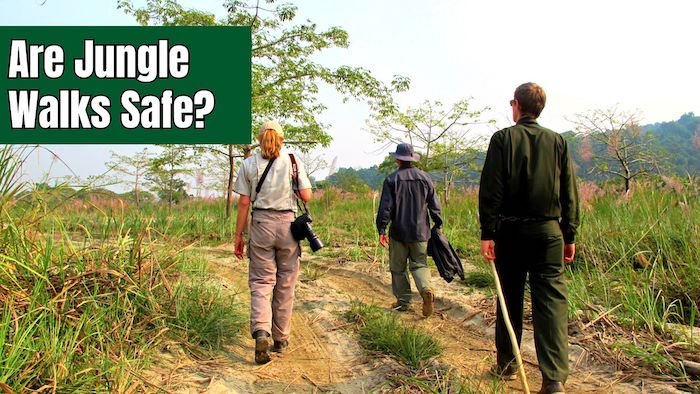Chitwan National Park, located in the subtropical lowlands of Nepal, is a UNESCO World Heritage Site and one of the country’s premier wildlife reserves. Covering an area of approximately 932 square kilometers, it is renowned for its diverse range of flora and fauna. Additionally, it includes the iconic big 6 animals such as Bengal tigers, one-horned rhinoceroses, Asian elephants, and various bird species. With a wide variety of animals waiting to be seen, many tourists try to see them during jungle walks. However, this leads to an important question, are jungle walks in Chitwan safe?
Yes, Chitwan’s jungle walks are safe and tourists can partake in them with no worries. Additionally, Chitwan National Park is well-patrolled by park rangers and security personnel, and the communities around Kumarwarti and Sauraha are friendly and welcoming.
Jungle walks in Chitwan National Park offer a unique and immersive way to experience the natural beauty and biodiversity of the region. It allows wildlife enthusiasts and nature lovers to venture into the heart of the jungle, observe animals in their natural habitats, and witness their behaviors up close.
As one of the best resorts in Chitwan with over 10 years of experience, we know about safety and security while operating jungle walks in the park. We have come up with this guide to help all visitors be safe and secure during their jungle safaris and walks in Chitwan.
Will I be Safe on a Jungle Walk in Chitwan?
Yes, you will be safe on a jungle walk in Chitwan. It is mandatory to be accompanied by experienced guides. They will provide you with essential information on how to stay safe during your safari in the Jungle.
That being said, it is important to note that you are walking through a jungle with live wild animals. There have been reports of individuals being attacked by wild animals. The last reported incident was in February 2023, when a local in Chitwan was attached by a Rhino and died. Although these incidents due occur, they are rare. To avoid such risks and issues during your jungle walk, guests should listen to their guides and the safety briefings they provide you before the safari.
Important safety tips for jungle walks in Chitwan can be found below:
How To Stay Safe on Jungle Walks in Chitwan National Park?
Chitwan National Park is considered safe for visitors. Ensuring a safe and enjoyable experience is essential, and this requires following guidelines and exercising caution. Various factors, such as the skillset of your guides, adherence to safety protocols, and awareness of potential risks, influence the safety of a jungle walks in Chitwan National Park, as in any wildlife adventure. Here are some aspects to consider regarding safety:
1. Experienced Guides:
The presence of experienced and knowledgeable guides is crucial. These guides are well-trained in wildlife behavior, safety measures, and first aid. They lead the group, provide information, and ensure safety throughout the jungle walk.
2. Safety Briefings:
Before embarking on the jungle walk, the guides provide participants with comprehensive safety briefings. This encompasses guidelines on staying together as a group, maintaining a safe distance from wildlife, understanding animal behavior, and following established trails.
3. Group Size and Supervision:
Jungle walks typically have a maximum group size, allowing for adequate supervision and personalized attention. Guides closely monitor participants, ensuring everyone’s safety and promptly addressing any concerns.
4. Pathways and Trails:
The park authorities establish designated trails and pathways to minimize encounters with potentially dangerous animals. Staying on these designated routes significantly reduces risks associated with venturing off into unknown areas.
5. Avoiding Risky Situations:
Guides prioritize safety by avoiding risky situations. They are trained to assess the environment and make informed decisions to prevent encounters with dangerous animals.
6. Animal Behavior Education:
Guides provide insights into animal behavior, helping participants understand how to react appropriately if they encounter wildlife. By doing this, it minimizes risks and promotes responsible behavior during the walk.
7. Weather Considerations:
Weather conditions can influence safety. Guides are knowledgeable about the local climate and are cautious about potential hazards related to rain, flooding, or extreme heat. Walks may be rescheduled or altered based on weather conditions.
8. First Aid Preparedness:
Guides typically carry basic first aid kits and are trained in administering first aid if needed. They can handle minor injuries and coordinate with appropriate authorities for more severe incidents.
9. Emergency Communication:
Guides often carry communication devices to ensure they can contact park authorities or emergency services if required. This provides an additional layer of safety.
10. Prohibited Actions:
Activities like feeding wildlife, making loud noises, or engaging in disruptive behavior are prohibited. Therefore, adhering to these rules is vital for the safety of both visitors and wildlife.
What Can You See During The Jungle Walk?

As a National Park in Nepal, Chitwan has a wide variety of animals, including the iconic Big Six! Encountering these wildlife species in their natural habitat and learning about their behaviors and roles in the ecosystem is a highlight of the jungle walk, providing participants with a deeper appreciation for the beauty and significance of Chitwan National Park.
The guide will facilitate these encounters and provide valuable insights into their behavior and ecology. Some highlighted wildlife species to be encountered during the Jungle walks in Chitwan include:
1. Bengal Tiger (Panthera tigris tigris):
The Bengal tiger is the apex predator of Chitwan National Park, a top-tier carnivore at the pinnacle of the food chain. Its iconic orange coat with dark stripes provides excellent camouflage in the grasslands and forests. Solitary and territorial, Bengal tigers are primarily nocturnal hunters, preying on deer and wild boar.
2. One-horned Rhinoceros (Rhinoceros unicornis):
The one-horned rhinoceros is a flagship species of Chitwan and a charismatic megafauna. This prehistoric-looking creature is a herbivore, mainly feeding on grasses, leaves, and fruits.
3. Asian Elephant (Elephas maximus):
Asian elephants, the largest land mammals in Asia, are gentle giants that inhabit the forests of Chitwan. These herbivores play a vital role in seed dispersal and shaping the landscape.
4. Sloth Bear (Melursus ursinus):
The shaggy-coated sloth bear is a sight to behold as it forages in the forest. They have a primarily insectivorous diet, feasting on ants, termites, and fruits.
5. Gharial (Gavialis gangeticus):
The gharial inhabits the rivers of Chitwan and is an endangered crocodilian species. With its long, slender snout, it primarily feeds on fish.
6. Sambar Deer (Rusa unicolor):
The Sambar deer is the largest deer species in Chitwan and a crucial prey item for carnivores.
7. Spotted Deer (Axis axis):
You can easily recognize spotted deer by their distinctive coat, and you will commonly see them in herds within the park.
8. Various Bird Species:
Chitwan is a paradise for birdwatchers, with over 540 species of birds. Guides will point out and share information about the diverse avian species, including the great hornbill, Bengal florican, eagles, owls, and others.
For more detailed information about Jungle Walks, you can check our The Big Six Safari Experience package.
Checklist for Jungle Walks in Chitwan National Park

This checklist will guide you in making the most of your jungle walk, embracing the sights, sounds, and wonders of Chitwan National Park:
- Sunscreen and insect repellent are essential when exploring Chitwan National Park. Also, October is optimal for wildlife sightings, although the heat might be quite intense. It’s also advisable to wear a sun hat. Bug spray is a must, given the abundant insect population, especially around areas frequented by rhinos and elephants.
- Dressing in attire that covers your body is vital, considering the dense jungle terrain. The vegetation houses spiders and bugs, necessitating protective clothing to reduce the risk of insect bites.
- Carrying a sufficient supply of water is crucial for your journey, particularly if you plan a half or full-day trek. One to two liters of water is recommended, considering there are no facilities for filtered water or shops within the park.
- Closed-toe shoes are a wise choice, offering protection from the abundance of red and black bugs on the trail. Vigilance is essential to spot and remove leeches, an unpleasant yet common encounter.
- A camera with a high-zoom lens is a necessary accessory for capturing wildlife, often at a distance for safety reasons.
- Hayfever tablets or antihistamines are advisable, given the pollen-heavy environment causing discomfort to those prone to allergies.
- When entering the park, it’s prudent to leave valuables such as wallets and passports in the hotel. In case of an unexpected encounter with wildlife, the recommendation is not to carry a backpack containing valuables. This action can serve as a diversion, ensuring the preservation of personal belongings in such situations. Overall, ensuring that you are well-prepared and exercise caution is vital for a safe and enjoyable exploration of Chitwan National Park.

Hello, my name is Jana and I’m from Germany.
I visited Chitwan last year and I can definitely say that jungle walks are not safe at all!!!
On 1st of May 2023 we were attacked my a sloth bear and my friend got bitten in her leg. It took us 2 hours to get out of the jungle and to the closest hospital. There was no helicopter rescue, our guides didn’t carry an emergency bag, we could only stop the bleeding with everything we had on us. My friend can be glad that she survived. Our guides didn’t react fast, we did the emergency treatment ourselves (I’m a docter, her boyfriend a military medic).
PLEASE STOP THE JUNGLE WALKS IN THE NATIONAL PARK!!!
Attacks a rare but they do happen and people there aren’t prepared for emergencies like this!